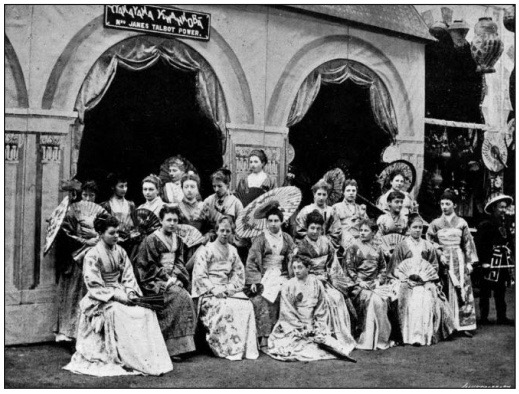The “Orient” as the Other
“The syllables of the word Araby were called to me through the silence in which my soul luxuriated and cast an Eastern enchantment over me.“
“Araby“, James Joyce
When reading Joyce, I noticed multiple references to Eastern exoticism. The first occurs in the dream of the boy in “The Sisters.” The boy dreams of “long velvet curtains and a swinging lamp of antique fashion” feeling that he had “been very far away, in some land where the customs were strange–in Persia“. The second is in the short story “Araby”, where the Araby Bazaar is imagined as a captivating and almost fantastical place.

The Araby Bazaar was a real bazaar in Ireland in 1984. According to one source, Joyce apparently actually visited this bazaar; however, the actual Araby Bazaar was much larger and popular than the one he described in “Araby.” The 1984 Araby Bazaar was a large spectacle featuring food, goods, acrobatics, and fireworks. The bazaar also had stalls that each had a different “oriental theme”. The stalls featured young women dressed in costumes that supposedly reflected different cultures from Moorish (pictured in the feature photo), to Egyptian and Japanese (pictured below).


The poster below is allegedly the poster for the actual Araby Bazaar. However, instead of calling the bazaar the Araby Bazaar, the poster labels the event as a “Grand Oriental Fete”. In the poster, oriental customs are portrayed as enticing and exotic entertainment, and the racism of the time shines through. There is an unsettling aspect to being labeled exotic. I am half Japanese, and when people describe my features as exotic I feel extremely uncomfortable. I think some of this unpleasant feeling is partly centered around the idea of otherness.

The idea of otherness is visualized in the geographical areas described as the Orient, which can be seen in the image below. Areas from Morocco to Japan are included in descriptions of oriental cultures. When looking at a map of what is generally considered the Orient, the main unifying feature appears to be that the areas are not Europe.

The definition of the Orient as an outsider group means that characterizations of the Orient were very vague and were mostly incorrect. This video on La Bayadere (an “orient ballet”) describes the Orient as when “Back in the day, they would take all of the places like Japan, India, China, Thailand, and just mash it all together and call it one place– the Orient.” Mashing all of the diverse and different cultures into the non-European “Orient” illustrates the Eurocentric perspective of perceived superiority over the otherness of the rest of the world.

The Irish as the Other
However, the concept of “otherness” is also not unfamiliar to the Irish. The Irish were also discriminated against and suffered under English rule. I want to add that my understanding of the concept of “the Orient” is greatly influenced by learning about Asian American history; however, Ireland’s interaction with the concept of the Orient has several more nuances than American conceptions. From the very very little I understand, there were some efforts to reclaim Irish culture by alluding to similarities in “Oriental culture”. Some (like perhaps Joyce) found some of these comparisons to be too romantic and thought them fantastical with little substance (similar to how the boy in “Araby” romanticized the bazaar, but found it to be lacking).
To end on a slightly happier note, the idea of otherness reminded me of an article I recently read. This article describes Ireland is contributing to COVID relief as gratitude for how the Choctaw Nation helped the Irish during the potato famine even though they were recently forced off their lands and endure the Trail of Tears.
“It is said that the Choctaw Nation heard about the famine from an Irish soldier overseeing the forced displacement of Native Americans — and, some experts believe, the Irish experience resonated with the Choctaw people. Like the Irish, Native Americans suffered under British colonial rule that resulted in hunger, genocide and disease outbreak. The British tried to put the Irish on reservations, as they did with Native Americans, and forced both groups to abandon their cultures and languages. So they decided to help, sending over funds that were used to purchase food, blankets and feed for livestock.”
Time Magazine
The Irish people remembered this act of kindness years ago and have been contributing to a COVID relief fund for Navajo and Hopi families. Most of the comments and donations on the GoFundMe page are from people expressing gratitude for generosity and kindness the Choctaw Nation showed for their Irish ancestors.


Hi Michelle! The theme of the “exotic” definitely unsettled me too because I’m half Korean and people have thrown this term at me so many times. Although it’s often meant as a backhanded compliment, it just enforces the idea of Otherness and many other harmful connotations (that people from these regions are passive, “backwards,” dangerous, therefore they must be subjugated, etc.) These pictures are super jarring though! I was hyperaware of the Orientalist undertones in “Araby” but I never considered digging into the actual history of the Bazaar beyond what was presented in the footnotes.